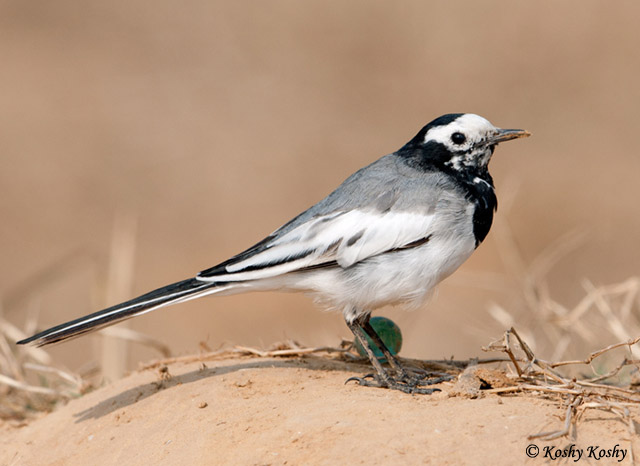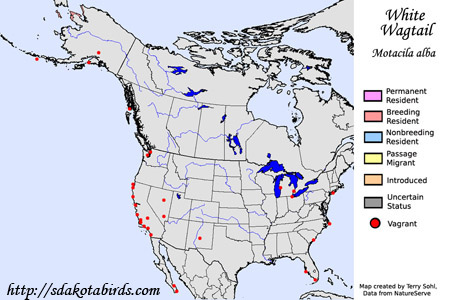| Length: 7.25 inches | Wingspan: 10.5 inches | Seasonality: Non-resident in South Dakota |
| ID Keys: White face with black big, nape, and crown, gray upperparts, white underparts, large white wing patch | ||
 The
White Wagtail is an extremely common bird throughout Asia and Europe, but in
North America, they are only typically found in northwest Alaska, where
limited breeding occurs along the coast. They have also been sighted
as vagrants in many parts of North America, most often along the west coast
of the United States, but also with some eastern U.S. records, and a handful
of records in the interior of the U.S. The "Black-backed Wagtail",
also found on rare occasions in North America, was once considered a
separate species, but is now considered a subspecies of the White Wagtail.
The Black-backed Wagtail is very similar in appearance, but instead of the
gray back pictured in the bird on the right, their back is black.
The
White Wagtail is an extremely common bird throughout Asia and Europe, but in
North America, they are only typically found in northwest Alaska, where
limited breeding occurs along the coast. They have also been sighted
as vagrants in many parts of North America, most often along the west coast
of the United States, but also with some eastern U.S. records, and a handful
of records in the interior of the U.S. The "Black-backed Wagtail",
also found on rare occasions in North America, was once considered a
separate species, but is now considered a subspecies of the White Wagtail.
The Black-backed Wagtail is very similar in appearance, but instead of the
gray back pictured in the bird on the right, their back is black.
Habitat: Breeding birds in Alaska are found around rocky cliffs and beaches, or sometimes on gravel bars on rivers. In their range in Eurasia, they can be found in a very wide variety of open and semi-open habitats.
Diet: Feeds on insects and spiders, but will also occasionally take other invertebrates such as worms, and will also sometimes feed on seeds, particularly when invertebrates are not available.
Behavior: Forages by walking along the ground in search of invertebrates. They may also sometimes fly from the ground to capture flying insects in mid-air. As with other Wagtail species, White Wagtails frequently wag their tails as they move about.
Nesting: The nest of a White Wagtail is a cup of grasses, sticks, moss, and other material, usually built in a protected area such as a rocky crevice. They have also adapted well to a human presence, and even in sparsely populated western Alaska, they may nest in a crevice in a building. They female usually lays between 5 to 7 eggs, and both parents help to incubate them. After the eggs hatch, both parents help to feed them. The young leave the nest after about 2 weeks, but typically remain in the care of the parents for another week or so.
Song: The song of a White Wagtail is a series of short, clear phrases, with each phrase consisting of two or three syllables.
Migration: Strongly migratory. Birds that breed in Alaska winter in southeast Asia. In their Eurasian range, some birds are permanent residents in more temperate zones. Birds in less temperate areas are migratory, with European birds mostly wintering in southern Europe near the Mediterranean, or in north Africa. Asian birds winter in the Middle East, India, and southeast Asia.
Interactive eBird map : Click here to access an interactive eBird map of White Wagtail sightings
Similar Species: Black-backed Wagtail. There are number of other black-and-white Wagtail species found in Eurasia that are somewhat similar.
Conservation Status: Populations may be decreasing overall, but they remain very large and are found over a wide geographic area. The IUCN lists the White Wagtail as a species of "Least Concern".
Further Information: 1) BirdGuides - White Wagtail
2) BirdLife International - White Wagtail
3) Nesting and Occurrence of White Wagtails in Alaska
Photo Information: Photo by "Koshy Koshy" - Photo taken on February 5th, 2012 at Garhi Bazidpur, Haryana, India - Photo licensed under Creative Commons Attribution 2.0 Generic License
| Click below for a higher-resolution map |
 |
| South Dakota Status: Non-resident in South Dakota |
Additional White Wagtail Photos (coming soon!!)
